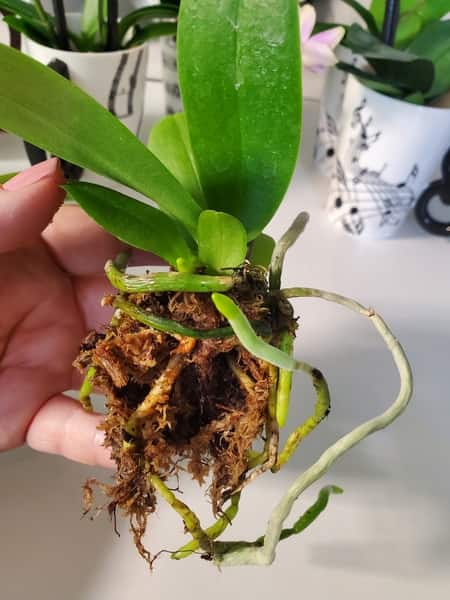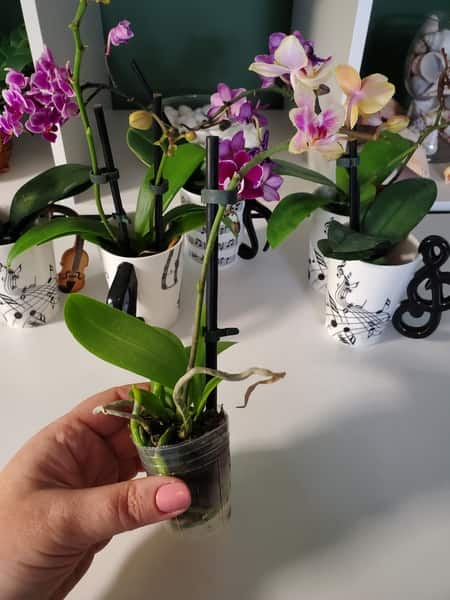When you start repotting for the first time, you can come across roots in several conditions: crackly brown, deathly yellow and pale, plump and green, or slimy black. Yellow roots are on that borderline decision: what are they? How did the orchid roots get this yellow color? And more importantly, what to do with them.
Yellow roots on orchids are not a sign they are sick. The yellow tinge indicates a lack of chlorophyll in the orchid roots since they haven’t had access to sunlight. Most likely, these yellow roots are in the middle of the vase, and not on the outside of the clear plastic pots, where luscious green roots prevail. The pale yellow doesn’t indicate a sign of decomposition and should not be cut off.

“Image credit: Orchideria.com © 2020
Repotting can be quite nerve-wracking experience. After all, orchids are known to be troublesome and panicky, prone to die from anything.
But don’t fret, because that’s not true.
As long as you have the right information, orchids have proven to forgive a lot of mistakes.
The first mistake is cutting off all the yellow roots.
Nurture the Yellow Orchid Root
In nature, orchid roots don’t live inside of planted pots (unless you have a terrestrial orchid, like Paphiopedilums or Cymbidiums). Most Phalaenopsis orchids (moth orchids) will be epiphytes, which means they cling to tree bark and secure themselves to other objects. They aren’t parasitic, but these roots will attach themselves to the tress, and be exposed to air, light, water from the rain, and wind currents. They detest being potted.
And yet we pot them.
This is why it’s necessary to use clear plastic pots when repotting orchids. The roots, independent if they are areal roots or roots that get stuck down into the potting medium, need light and air. The sunlight interacts with the velamen in the roots, which contains chlorophyll. The chlorophyll converts the sunlight into energy.
When the roots are not exposed to sunlight, they don’t produce as much green color, which is present in the chlorophyll. They become deathly pale-colored, like a washed-out green—but it’s so anemic looking, it becomes almost yellow.
Know your yellows: A yellow root that is plump, firm to the touch, and resistant to bending should be kept intact. This yellow color looks like Parmesan cheese, sugar cookie, pancake, sandcastle, and eggnog coloring.
When you repot, you have two options to position the healthy yellow orchid roots:
(1) Try to move these roots to the outside of the pot. If you notice, most of the yellow roots in this condition will be in the center of the pot. There is not way to get sunlight to them, and that is why they have the lack of green in them. When repotting, you can spread them toward the outside of the pot.
(2) You can leave them in the middle, and they’ll remain yellow. There is no harm in this method, but the energy they’ll get from the sun will be, well, nothing. They’ll do exactly what they were doing before you potted them: absorbing water and nutrients, but little air and little sunlight.
To nurture this yellow orchid root, it will need more sun. For this method, we prefer to arrange the roots aimed toward the exterior of the pot. This way, when they grow a little bit more, they’ll come in contact with the exterior of the pot and receive sunlight. The more sun, the more energy. The more energy, the more root, leaf, pseudobulb, and stem power the orchid has. It’s valid to aim for nurturing this yellow root to become a nice, grassy-green color.
Cut Off Unhealthy, Mushy, Yellow Orchid Roots
A latte-colored yellow root, more toward an apricot, cider, bronze-brown, should be cut.
To know the difference, don’t only rely on color alone.
If the orchid root is flimsy, almost an amber-brown color, and has no resistance when pressed between your fingers, it should be cut off.

This yellow is not healthy, and will not get better. It’s on its way to decomposing within a few months—and you sure don’t want that in your new orchid potting medium.
The first step of a decomposing root is to lose the components inside the cells: ribosomes, enzymes, chloroplasts, mitochondria, and other cell components. The dying components lose their green color along with their firmness and shape. Result: the roots become a sickly yellow color, hinting toward brown.
Hydrate Yellow, Paper-like, Dry Roots
You need to do some careful observation of your watering habits, humidity, and light conditions. If your orchid roots are yellow and crunchy, then your problem may be a lack of humidity. This happens a lot with areal roots, where there is water in the pot, and the plant is hydrated, but not enough water droplets in the air. The environment is just too dry for them.
These roots can be saved if they aren’t dried out all the way. If you water them and they change color, even if slightly, there’s hope. Layer some damp sphagnum moss over the tops of areal roots and mist them twice or three times daily. You can also get a humidifier to raise the relative humidity in the overall environment.
(If you’re looking for ideas for humidifiers, check out this article. I selected three different kinds of humidifiers—cool mist, ultrasonic, warm-vapor—and explained what is best for each environment so you can pick the right one for your space.)
Another idea to nurture the yellow, paper-like dry roots is to keep a humidity tray under the orchid pot. This will help somewhat, but not to the full extent of a humidifier or sphagnum moss.
After a few weeks, check to see if the root has changed any. Sometimes the dryness is so severe the velamen in the root will not cure. In this case, if it’s an aerial root, you can leave it alone or cut it off. It’s your personal preference since it will do no harm either way.
If you need a suggestion of a humidifier, this is the one I use (Affiliate Link ). Its quiet, small, and I have to refill it every 4 days. But be sure to check out the article first on how I choose mine. My growing conditions may not be the same as yours.
). Its quiet, small, and I have to refill it every 4 days. But be sure to check out the article first on how I choose mine. My growing conditions may not be the same as yours.
Don’t Stop Learning!
If you want to be included in more information and get a 14-page fertilization guide, please sign up for my newsletter. I don’t spam, but send emails out bi-monthly with some curious topics of interest. If you want more information, click here to go to a specific page on this website where I explain it more in detail.

Also, if you are looking for an orchid journal to keep your notes specifically about orchid care, check out my 2 solutions for that on this page. If note-keeping isn’t your thing, then there is a free excel spreadsheet that you can download. Click here for more information on how to do that.
If you subscribe to my newsletter, I will send you a 14-page guide on the main tips of orchid fertilizer. It is downloadable and you can print it out on your computer. I designed the guide to double up as a coloring book, just to make it fun.
Further Reading Suggestions:
Don’t just take my word for what is written here. Continue researching other articles about yellow roots on orchids, because everyone has a different point of view and unique techniques that work for them. Here are a few other articles from more scientific websites if you’d like to continue your research on photosynthetic roots on orchids:
–Title: “The velamen protects photosynthetic orchid roots against UV-Bdamage, and a large dated phylogeny implies multiple gains andlosses of this function during the Cenozoic” written by Guillaume Chomicki and others, published on New Phytologist states that,”most orchid species evolved photosynthetic roots, a way to increase photosynthetic surface and hence carbon gain. Some 300 epiphytic orchid species rely exclusively upon root photosynthesis for carbon gain.” Even though the article is about the UV-B rays and how the velamen protects the roots, it does touch upon the effects of sun on the roots.
states that,”most orchid species evolved photosynthetic roots, a way to increase photosynthetic surface and hence carbon gain. Some 300 epiphytic orchid species rely exclusively upon root photosynthesis for carbon gain.” Even though the article is about the UV-B rays and how the velamen protects the roots, it does touch upon the effects of sun on the roots.
–Title: “Orchid Roots ” written by Sue Bottom, published on Saint Augustine Orchid Society talks aboutall items related to orchid roots, not only the light factor. It’s a very accessible, presented in a 4-page PDF version, and pleasant read.
” written by Sue Bottom, published on Saint Augustine Orchid Society talks aboutall items related to orchid roots, not only the light factor. It’s a very accessible, presented in a 4-page PDF version, and pleasant read.
–Title: “Photosynthesis in a Vanda sp orchid with Photosynthetic Roots “ written by SuhailarSma-Air, published on Journal of Plant Physiology talks aboutinteresting finds on the orchid roots of a Vanda. In summary, this article explained that: “Photosynthesis of leaves was low in the morning with a midday peak; roots were only transiently and ephemerally photosynthetic when wet; and Roots were homiochlorophyllous but rapidly became dormant again after drying.”
“ written by SuhailarSma-Air, published on Journal of Plant Physiology talks aboutinteresting finds on the orchid roots of a Vanda. In summary, this article explained that: “Photosynthesis of leaves was low in the morning with a midday peak; roots were only transiently and ephemerally photosynthetic when wet; and Roots were homiochlorophyllous but rapidly became dormant again after drying.”
I added this one to the list since most vanda orchid’s I know of are grown in hanging baskets and have roots that dangle down in to the air. Although the vanda roots are exposed to air and sun, more so than Phalaenopsis, I thought it was interesting to see the effects of light on the roots.If you have any questions that weren’t answered in this tutorial, please leave a comment below and I’ll get back with you.
I love to interact with other orchid enthusiasts, yet I’ve been having a few problems with spammers on the site. If your email is your name, I’ll have to delete your comment. Sorry.
Happy Cultivating!



Amanda ~ Thank YOU so very much. I love your research and helpful info and I am in absolutely in love with orchids as well. Much appreciated! 🙂 Many blessings to you and your family!
“Photosynthesis of leaves was low in the morning with a midday peak; roots were only transiently and ephemerally photosynthetic when wet; and Roots were homiochlorophyllous but rapidly became dormant again after drying.”
Can someone translate this (to plain English) please!